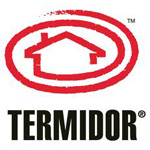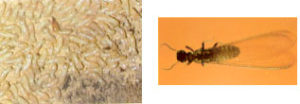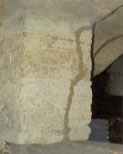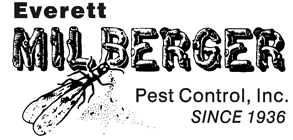Controlling eastern subterranean termites is not as easy as you may think. Just because you may not see any evidence of termite damage, does not always mean you don’t have them.
What are termites?
Termites are small white, tan, or black insects that can cause severe destruction to wooden buildings. These pests cause serious damage to wooden structures and posts and may also attack stored food, books, and household furniture.
How much damage do termites cause?
Termites eat 24 hours a day, 7 days a week, meaning damage to wood in and around a structure can happen very quickly. In fact, the NPMA estimates that termites cause $5 billion in property damage each year. That’s why here in Kansas City; Millberger Pest Control takes termite control very seriously. While most companies are only certified in one termite control system, we specialize in two, giving you a choice depending on what you want from your pest control. Below we outline the two systems, (Termidor and Sentricon), so you can pick the one that’s right for you.
Sentricon
![]() Milberger Pest Control’s Sentricon* Termite Colony Elimination System not only does away with termites much more efficiently than previous methods but also eliminates the mess. The only part of the Monitor/Treatment unit that can be seen above ground is the cap, and it closely resembles the heads of an underground sprinkler system. The same unit is used to detect the presence of termites and treat them once discovered.
Milberger Pest Control’s Sentricon* Termite Colony Elimination System not only does away with termites much more efficiently than previous methods but also eliminates the mess. The only part of the Monitor/Treatment unit that can be seen above ground is the cap, and it closely resembles the heads of an underground sprinkler system. The same unit is used to detect the presence of termites and treat them once discovered.
![]()
- Uses active ingredients only when termites are present
- Can detect termites before they enter structure
- No drilling to the structure required
- Eliminates entire termite colony
 TERMITE SPECIES SERIES:
TERMITE SPECIES SERIES:
• Visit the Termidor website to learn more about this product.
Eastern Subterranean Termite
Reticulitermes Flavipes (Kollar)
The Eastern Subterranean termite is the most common and most widely distributed termite in North America. It is a problem for homeowners from southern Ontario in Canada, south throughout the Eastern United States and as far west as Montana.
This native American pest feeds on such cellulose materials as structural wood, wood fixtures, paper, books, and cotton. Occasionally, it will even attack the roots of shrubs and trees.

A mature colony of Eastern Subterranean termites can range from a low of 20,000 to a high of 5 million workers, with an average of 300,000. The colony’s queen will add 5,000 to 10,000 eggs per year to the total.
While Eastern Sub termite colonies are not the largest termite colonies you can find, there will often be more than one of them working in a single building. Signs of Easterns include dirt-colored tubes built to serve as protected paths form the earth to the wood the termites are feeding on, and the translucent wings shed by the kings and queens during swarming. Swarming usually occurs in the spring, but other smaller swarms can occur throughout the summer and fall.
Some quick facts about Eastern Sub termites:
- On average, Eastern Sub termite colony can consume 5 grams of wood per day, the equivalent of 2-1/3 linear feet of a 2’x 4’ pine board annually.
- Colony growth is slow, and it may take years before swarmers are produced.
- Eastern Sub termites can enter buildings through cracks less than 1/64” wide.
- The termite colony is made up of different types (castes) of termites – each with seperate work responsibilites.
 Although Eastern Sub termite colonies are largely located in the ground below the frost line, secondary colonies can exist above ground, and examples of true above ground colonies existing without any ground contact have been seen. However, such above ground colonies have access to moisture and often the source is a roof or plumbing leak.
Although Eastern Sub termite colonies are largely located in the ground below the frost line, secondary colonies can exist above ground, and examples of true above ground colonies existing without any ground contact have been seen. However, such above ground colonies have access to moisture and often the source is a roof or plumbing leak.- Eastern Sub termites will often build mud tubes for travel between their colonies and their food source.
- The king and queen in a colony can live for 10 to 30 years, while workers live for about two years.
